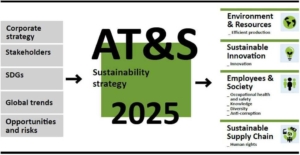Strategic Sustainability: Action Fields – AT&S explains
The other week, we started telling you about the AT&S sustainability strategy and tried explaining the intricacies of it all. Of course, we essentially only dipped a tentative toe into the water – there is much much more to talk about and explain when it comes to sustainability at AT&S. Today, let us delve a little deeper and begin to explain the four strategic fields of our strategy.
The sustainability strategy was created in mind of the Group-wide strategic alignment, from which the four strategic fields of action are derived.

All key stakeholders such as employees, customers, suppliers and shareholders were involved in the strategy process to define these fields of action. The stakeholder survey carried out in 2018/19 and the topics arising from the materiality analysis, as well as global trends and developments, were also taken into account.
Based upon the non-financial risk assessment conducted in the fiscal year 2019/20, AT&S started to integrate non-financial opportunities related to the environment, social matters and responsible governance (so-called ESG risks) into its Group-wide strategic orientation. This, amongst other things, also included climate-relevant and physical risks. These risks concern “the chronic or acute effects of climate change and global warming”, as well as how they affect the operating activities of AT&S and take the environment, risks and opportunities into consideration that arise from transitioning to a low-carbon, climate-resilient economy. AT&S regarded this transition as an opportunity and proceeded to develop an energy strategy, setting ambitious decarbonisation targets and decided to use this chance to position themselves as a climate-resilient company.
The UN’s Sustainable Development Goals were also included in the strategy development process and in the derivation of the four strategic action areas. This was done by assessing all 17 goals and 169 subgoals and identifying which were the most significant for AT&S as a company, which in turn resulted in three SDGs being rated as central and another six as relevant. These nine SDGS are depicted in the image on the right.
Based upon the non-financial risk assessment conducted in the fiscal year 2019/20, AT&S started to integrate non-financial opportunities related to the environment, social matters and responsible governance (so-called ESG risks) into its Group-wide strategic orientation. This, amongst other things, also included climate-relevant and physical risks. These risks concern “the chronic or acute effects of climate change and global warming”, as well as how they affect the operating activities of AT&S and take the environment, risks and opportunities into consideration that arise from transitioning to a low-carbon, climate-resilient economy. AT&S regarded this transition as an opportunity and proceeded to develop an energy strategy, setting ambitious decarbonisation targets and decided to use this chance to position themselves as a climate-resilient company.
Like we said, the topic of sustainability is a big one at AT&S – and this was only a small intro to our four strategic fields of action. Join us again in the coming weeks, where we will be going into more detail about our first sustainability pillar “Environment & Resources” and the goals allocated to it.

分享文章:




